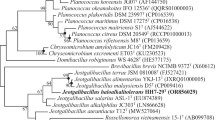Abstract
A halophilic archaeal strain YJ-8-ST was isolated from Yangjiang marine solar saltern, China. Cells from strain YJ-8-ST were pleomorphic, lysed in distilled water, stained Gram-negative, and formed red-pigmented colonies on agar plate. Optimal growth of the strain was obtained at 3.1 M NaCl (range 1.4–4.8 M), 0.1 M MgCl2 (range 0.005–1.0 M), 37 °C (range 20–50 °C), and pH 7.5 (range 5.5–9.5). The major polar lipids are phosphatidylglycerol (PG), phosphatidylglycerol phosphate methyl ester (PGP-Me), sulfated mannosyl glucosyl diether (S-DGD-1), and mannosyl glucosyl diether (DGD-1). The 16S rRNA gene and rpoB′ gene of strain YJ-8-ST were phylogenetically related to the corresponding genes of Halobium palmae (96.9–97.2 and 92.7% similarities, respectively). The DNA G+C content of strain YJ-8-ST was determined to be 68.9 mol%. The phenotypic, chemotaxonomic, and phylogenetic characteristics suggested that strain YJ-8-ST (=CGMCC 1.12553T = JCM 30029T) represents a new species of Halobium, for which the name Halobium salinum sp. nov. is proposed.

Similar content being viewed by others
References
Cui H-L, Zhou P-J, Oren A, Liu S-J (2009) Intraspecific polymorphism of 16S rRNA genes in two halophilic archaeal genera, Haloarcula and Halomicrobium. Extremophiles 13:31–37
Cui H-L, Gao X, Yang X, Xu X-W (2010) Halorussus rarus gen. nov., sp. nov., a new member of the family Halobacteriaceae isolated from a marine solar saltern. Extremophiles 14:493–499
Dussault HP (1955) An improved technique for staining red halophilic bacteria. J Bacteriol 70:484–485
Felsenstein J (1981) Evolutionary trees from DNA sequences: a maximum likelihood approach. J Mol Evol 17:368–376
Fitch WM (1971) Toward defining the course of evolution: minimum change for a specific tree topology. Syst Zool 20:406–416
Gupta RS, Naushad S, Baker S (2015) Phylogenomic analyses and molecular signatures for the class Halobacteria and its two major clades: a proposal for division of the class Halobacteria into an emended order Halobacteriales and two new orders, Haloferacales ord. nov. and Natrialbales ord. nov., containing the novel families Haloferacaceae fam. nov. and Natrialbaceae fam. nov. Int J Syst Evol Microbiol 65:1050–1069
Gupta RS, Naushad S, Fabros R, Adeolu M (2016) A phylogenomic reappraisal of family-level divisions within the class Halobacteria: proposal to divide the order Halobacteriales into the families Halobacteriaceae, Haloarculaceae fam. nov., and Halococcaceae fam. nov., and the order Haloferacales into the families, Haloferacaceae and Halorubraceae fam nov. Antonie Van Leeuwenhoek 109:565–587
Ivanov VM (2004) The 125th anniversary of the Griess reagent. J Anal Chem 59:1002–1005
Kim O-S, Cho Y-J, Lee K, Yoon S-H, Kim M, Na H, Park S-C, Jeon YS, Lee J-H, Yi H, Won S, Chun J (2012) Introducing EzTaxon-e: a prokaryotic 16S rRNA gene sequence database with phylotypes that represent uncultured species. Int J Syst Evol Microbiol 62:716–721
Marmur J, Doty P (1962) Determination of the base composition of deoxyribonucleic acid from its thermal denaturation temperature. J Mol Biol 5:109–118
McDade JJ, Weaver RH (1959) Rapid methods for the detection of gelatin hydrolysis. J Bacteriol 77:60–64
Minegishi H, Kamekura M, Itoh T, Echigo A, Usami R, Hashimoto T (2010) Further refinement of the phylogeny of the Halobacteriaceae based on the full-length RNA polymerase subunit B’ (rpoB′) gene. Int J Syst Evol Microbiol 60:2398–2408
Mori K, Nurcahyanto DA, Kawasaki H, Lisdiyanti P, Yopi Y, Suzuki K-I (2016) Halobium palmae gen. nov. sp. nov. an extremely halophilic archaeon isolated from a solar saltern. Int J Syst Evol Microbiol 66:3799–3804
Oren A, Ventosa A, Grant WD (1997) Proposed minimal standards for description of new taxa in the order Halobacteriales. Int J Syst Bacteriol 47:233–238
Oren A (2014) Taxonomy of halophilic Archaea: current status and future challenges. Extremophiles 18:825–834
Saitou N, Nei M (1987) The neighbor-joining method: a new method for reconstructing phylogenetic trees. Mol Biol Evol 4:406–425
Stackebrandt E, Ebers J (2006) Taxonomic parameters revisited: tarnished gold standards. Microbiol Today 33:152–155
Tamura K, Stecher G, Peterson D, Filipski A, Kumar S (2013) MEGA6: molecular evolutionary genetics analysis version 6.0. Mol Biol Evol 30:2725–2729
Wang Z, Xu J-Q, Xu W-M, Li Y, Zhou Y, Lü Z-Z, Hou J, Zhu L, Cui H-L (2016) Salinigranum salinum sp. nov., isolated from a marine solar saltern. Int J Syst Evol Microbiol 66:3017–3021
Acknowledgements
This work was supported by the National Natural Science Foundation of China (No. 31370054) and the 11th “Six Talents Peak” Project of Jiangsu Province (No. 2014-SWYY-021). We are grateful to Dr. Koji Mori (NITE Biological Resource Center, Japan) for kindly providing the type strain (Halobium palmae NBRC 111368T).
Author information
Authors and Affiliations
Corresponding author
Ethics declarations
Conflict of interest
The authors declare that no conflict of interest exists.
Additional information
The Digital Protologue database Taxon Number for strain YJ-8-ST is TA00230. The GenBank/EMBL/DDBJ accession numbers for the rrnA and rrnB of 16S rRNA, and rpoB′ gene sequences of strain YJ-8-ST are KC918818, KX171225, and KX171226, respectively.
Electronic supplementary material
Below is the link to the electronic supplementary material.
Rights and permissions
About this article
Cite this article
Li, Y., Zhou, Y., Lü, ZZ. et al. Halobium Salinum sp. nov., Isolated from a Marine Solar Saltern. Curr Microbiol 75, 6–10 (2018). https://doi.org/10.1007/s00284-017-1343-6
Received:
Accepted:
Published:
Issue Date:
DOI: https://doi.org/10.1007/s00284-017-1343-6




